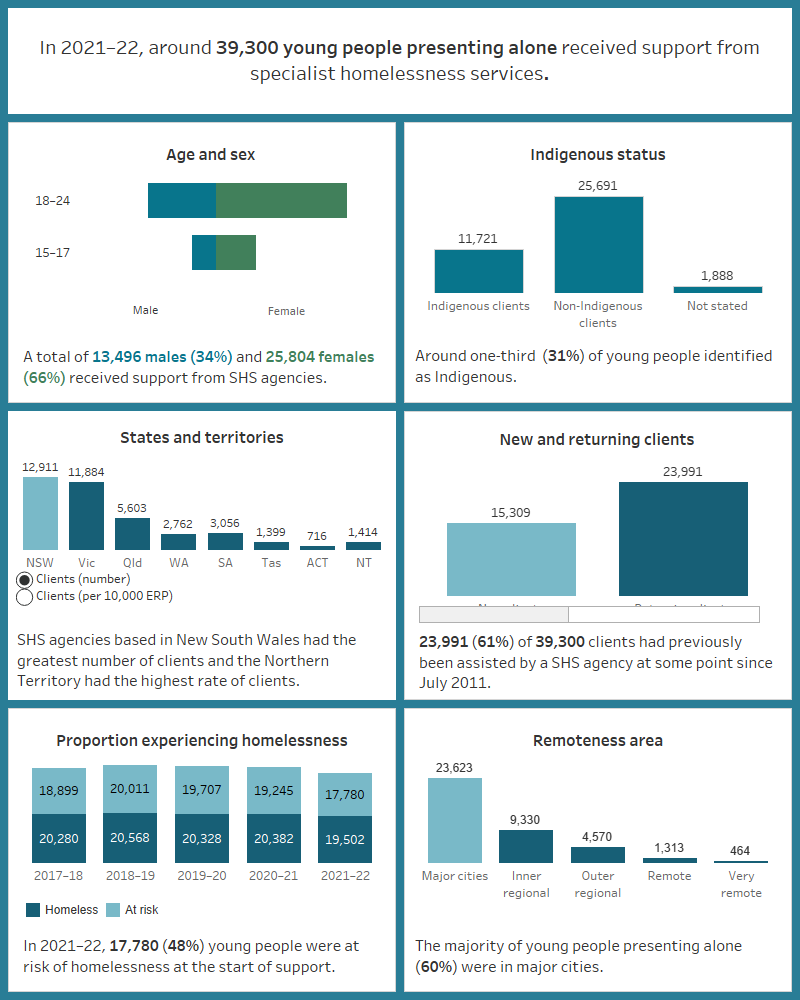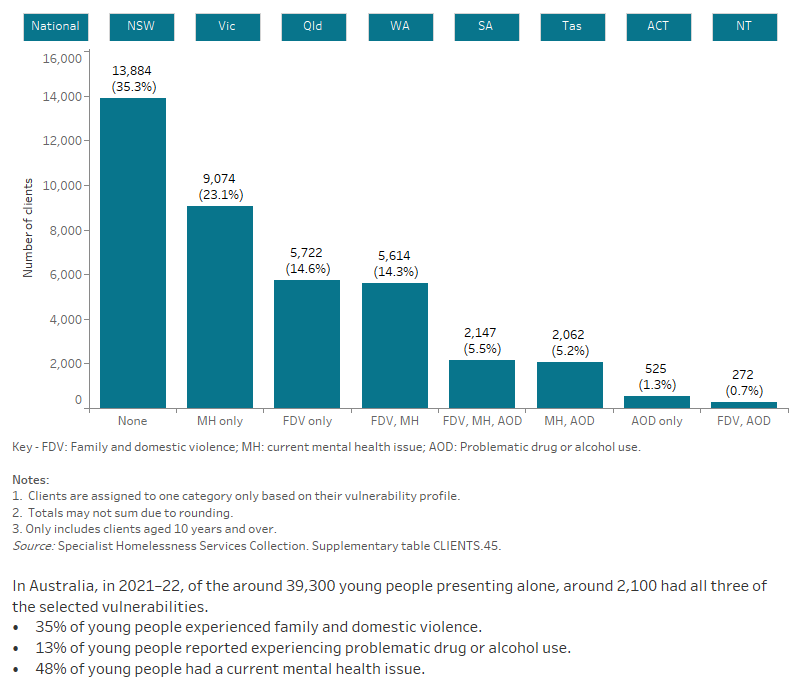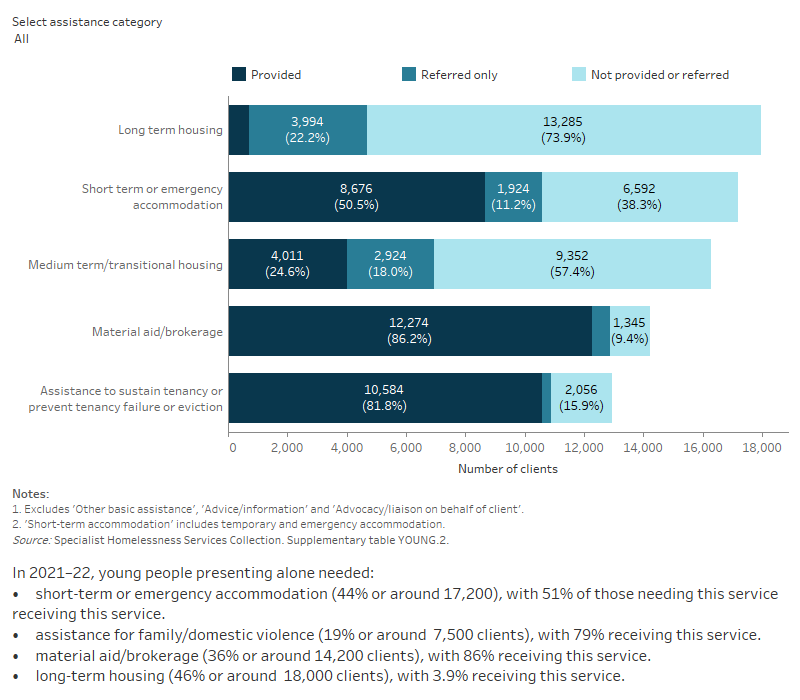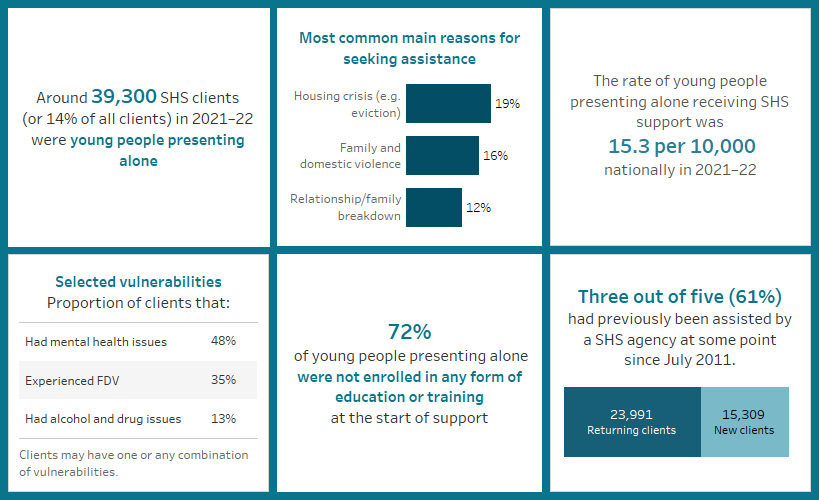Young people presenting alone
The disruptive effect of experiencing homelessness during one’s youth can have many far-reaching effects (Heerde and Patton 2020). Disruptions to education and transition to employment can harm future job opportunities and potential earnings, while disruptions to social life can harm social networks. Harsh living conditions can leave young people traumatised and at greater risk of experiencing persistent homelessness (Scutella et al. 2012). These far-reaching impacts are often unique to young people’s experience of homelessness, as many have not yet developed the skills required for independent living.
Youth homelessness often stems from difficult home lives and challenging family relationships (Gaetz et al. 2016; Kalemba et al. 2022). Family relationships and home lives burdened by regular instances of neglect, conflict, and abuse (including physical, sexual, substance and/or emotional) can make a young person’s living conditions emotionally unbearable and/or physically unbearable. While some young people may endure through these difficult home lives, many also leave, even without another home to move to (Kalemba et al. 2022). Other challenges, such as problematic drug and/or alcohol use, mental health issues and shortages to affordable housing or poverty can equally contribute – directly or indirectly – to young people’s experience of homelessness (Flatau et al. 2022; Hodgson et al. 2013).
In recognition of the severe impact that homelessness has on the lives of young Australians, children and young people are a national priority homelessness cohort in the National Housing and Homelessness Agreement (CFFR 2018) (see Policy section for more information).
Client characteristics
Figure YOUNG.1: Key demographics, young people presenting alone, 2021–22
This interactive image describes the characteristics of around 39,300 young people presenting alone who received SHS support in 2021–22. Most clients were female, aged 18–24 years. Around a third were Indigenous. New South Wales had the greatest number of clients and the Northern Territory had the highest rate of clients per 10,000 population. The majority of clients had previously been assisted by a SHS agency since July 2011. Half were experiencing homelessness at the start of support. Most were in major cities.

Young people presenting alone (39,300 clients) were the fourth largest SHS client group in 2021–22, making up around 14% of all SHS clients (Supplementary Table CLIENTS.39).
Selected vulnerabilities
Young people presenting alone may face additional vulnerabilities that make them more susceptible to homelessness, such as family and domestic violence, mental health issues and problematic drug and/or alcohol use.
Figure YOUNG.2: Young people presenting alone, by selected vulnerability characteristics, 2021–22
This interactive bar graph shows the number of clients also experiencing additional vulnerabilities, including having a current mental health issue, problematic drug and/or alcohol use, or experiencing family and domestic violence. The graph shows both the number of clients experiencing a single vulnerability only, as well as combinations of vulnerabilities, and presents data for each state and territory.

Service use patterns
The service use patterns of young people presenting alone to an SHS agency has generally been stable over time. Between 2017–18 and 2021–22 (Supplementary table CLIENTS.46):
- The average number of support periods per client has remained at 1.9 support periods.
- The median number of nights accommodated has stayed between 43 (in 2019–20) to 46 (in 2021–22) nights.
- The proportion of clients receiving accommodation has remained around 31%.
- The length of support (median number of days) has increased to 62 days in 2021–22, from 49 days in 2017–18.
Main reasons for seeking assistance
In 2021–22, the main reasons for seeking assistance among young people presenting alone were (Supplementary table YOUNG.5):
- housing crisis (19% or around 7,200 clients)
- family and domestic violence (16% or 6,200 clients)
- relationship/family breakdown (12% or 4,700 clients).
Young people experiencing homelessness at first presentation identified housing crisis (22%, compared with 15% of clients at risk) or inadequate or inappropriate dwelling conditions (16%, compared with 8.3% at risk) as the main reason for seeking assistance more commonly than those at risk of homelessness (Supplementary table YOUNG.6). Family and domestic violence (19%, compared with 11% of homeless clients) was the most commonly reported main reason for seeking assistance among young people presenting alone who were at risk of homelessness (Supplementary table YOUNG.6).
Services needed and provided
Similar to the overall SHS population in 2021–22, the majority of young people presenting alone needed general services that were provided by SHS agencies including advice/information, advocacy/liaison on behalf of the client and other basic assistance.
Young people presenting alone were more likely than the overall SHS population to request services including (Supplementary tables YOUNG.2, CLIENTS.24):
- living skills/personal development (33%, compared with 17%), with 92% receiving this service
- educational assistance (18%, compared with 8%), with 74% receiving this service
- employment assistance (18%, compared with 5.9%), with 72% receiving this service
- training assistance (12%, compared with 3.7%), with 70% receiving this service.
Figure YOUNG.3: Young people presenting alone, by services needed and provided, 2021–22
This interactive stacked horizontal bar graph shows the services needed by young people presenting alone and their provision status. Advice/information was the most needed and most provided service. Long term housing was the least provided service.

Housing situation and outcomes
Outcomes presented here highlight the changes in clients’ housing situation at the start and end of support. That is, the place they were residing before and after they were supported by a SHS agency. The information presented is limited only to clients who have stopped receiving support during the financial year, and who were no longer receiving ongoing support from a SHS agency. In particular, information on client housing situations at the start of their first period of support during 2021–22 is compared with the end of their last period of support in 2021–22. As such, this information does not cover any changes to their housing situation during their support period.
For young people presenting alone in 2021–22, around 13,200 clients (54%) were experiencing homelessness at the start of support; 6,900 (28%) were couch surfing. By the end of support, 58% of clients were housed (Supplementary table YOUNG.3).
By the end of support, many young people presenting alone to a SHS agency had achieved or progressed towards a more positive housing solution. That is, the number and/or proportion of clients ending support in public or community housing (renter or rent-free) or private or other housing (renter or rent-free) had increased compared with the start of support (Supplementary table YOUNG.4):
- One-third (33% or 4,000 clients) of young people presenting alone who were experiencing homelessness at the start of support were housed.
- Almost one-quarter were living in private rental accommodation (2,900 clients or 24%).
- For those at risk of homelessness, almost 9 in 10 (9,100 clients or 86%) were housed; mostly in private rental accommodation (6,500 clients or 61%).
Figure YOUNG.4: Housing situation for young people presenting alone with closed support, 2021–22
This interactive Sankey diagram shows the housing situation (including rough sleeping, couch surfing, short-term accommodation, public/community housing, private housing and institutional settings) of young people presenting alone with closed support periods at first presentation and at the end of support. The diagram shows clients’ housing situation journey from start to end of support. Most clients started and ended support in private housing or other housing.
Council on Federal Financial Relations (2018) National Housing and Homelessness Agreement, CFFR website, accessed 3 October 2019.
Flatau P, Lester L, Seivwright A, Teal R, Dobrovic J, Vallesi S, Hartley C and Callis Z (2022) Ending homelessness in Australia: An evidence and policy deep dive, Centre for Social Impact, doi:10.25916/ntba-f006.
Gaetz S, O’Grady B and Schwan S (2016) Without a Home: The National Youth Homelessness Survey, Homeless Hub, Toronto.
Heerde JA & Patton GC (2020) ‘The vulnerability of young homeless people’, Lancet, 5(6):302–3, doi: 10.1016/S2468-2667(20)30121-3.
Hodgson KJ, Shelton KH, van den Bree MB and Los FJ (2013) ‘Psychopathology in young people experiencing homelessness: A systematic review’, American journal of public health, 103(6):e24-e37, doi: 10.2105/AJPH.2013.301318.
Kalemba J, Kos A, Greenland N, Plummer J, Brennan N, Freeburn T, Nguyen T. and Christie R (2022) Without a home: First-time youth homelessness in the COVID-19 period, Mission Australia.
MacKenzie D, Hand T, Zufferey C, McNells S, Spinney A and Tedmanson D (2020) ‘Redesign of a homelessness service system for young people’, AHURI Final Report 327, Australian Housing and Urban Research Institute Limited, doi: 10.18408/ahuri-5119101.
Scutella R, Johnson G, Moschion J, Tseng Y and Wooden M (2012) ‘Wave 1 Findings’, Journeys Home Research Report No. 1, report to the Australian Government Department of Families, Housing, Community Services and Indigenous Affairs (FaHCSIA), Melbourne Institute of Applied Economic and Social Research.



